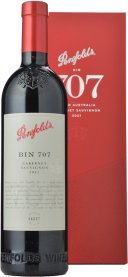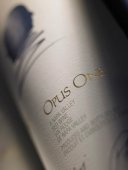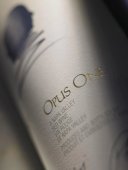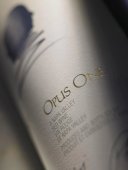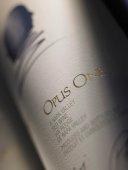$100 and over
Penfolds Bin 707
Bin 707 is a Cabernet Sauvignon reflection of Grange, intensely-flavoured fruit, completion of fermentation and maturation in new oak, expressing a Penfolds understanding of multi-vineyard, multi-region fruit sourcing. Bin 707 was first vintaged in 1964. The wine was not made from 1970 to 1975 when fruit was directed to other wines, nor in 1981, 1995, 2000, 2003 or 2011 (when fruit of the required style and quality was not available). Full bodied and with proven cellaring potential, Bin 707 retains a secure place among the ranks of Australias finest Cabernets.
Moss Wood Cabernet Sauvignon
One of Australia's icon wines, this is Cabernet at its very best. This wine is the very definition of power and elegance. Hand crafted by Keith Mugford and his team in the Margaret River, Moss Wood deservedly fits in the Exceptional category of Langton's Classification of Australian Wine.
Harlan Estate 'The Mascot' Cabernet Sauvignon
The domain traces its beginning to the founding in 1984 of Harlan Estate, located in the western hills of Oakville and conceived as a “first growth of California.” In 1996, the family established BOND, a portfolio of “Grand Cru” vineyards whose wines showcase the range of expression of cabernet sauvignon across distinct geographical sites within the Napa Valley. As these varied sites were gradually replanted, many of the young vines contributed to my project. Yet, despite these distinguished origins, my early endeavour could only hint at the individual character embodied by each of our grands vins. The Mascot is a Cabernet Sauvignon predominant blend alongside a balance of Cabernet Franc, Merlot, Petit Verdot & Malbec. It started out as a small project shared among the family, winemaking team and close friends .The wine showed charm and over time drew an affectionate following - so enthusiastic a following that they felt this intimate bottling deserved to have an identity of its own. The team took a little convincing, as the wine existed at first in very small quantities. But as more of the newer vines reached an age appropriate to warrant inclusion in the blend (typically 7 - 12 years) a certain number of barrels could be set aside for this project on an annual basis. Drawing fruit from blocks of recently replanted vineyards, The Mascot shares a glimpse into the evolution of its parent estates: a youthful snapshot of their future. The vineyard’s Harlan, BOND and Promontory are part of a yearly replanting program, albeit a very small percentage of the overall size of the vineyards to maintain vine health. This of course means each estate has a small evolving parcel of younger vines which when ready are selected for The Mascot. Each parcel is made separately at its respective wineries then blended during the middle to later stages of the barrel aging. At the core of the philosophy of The Mascot is the family’s passion to ensure the wine is ready for enjoyment immediately on release, hence its aged for a significant time in barrel and bottle before being made available to purchase. From the start, the principal characteristic of The Mascot was vigor tempered by approachability. We decided to mature the wine a little longer, so that, upon release, it was delicious to drink and intensely vibrant, with the force and depth that enabled extended aging, a wine to enjoy viscerally and without excessive reverence. In short, the wonderful wine to share among friends and family. Following a vintage full of changing conditions and demanding decision points, the steady and pleasant progress of the 2018 vintage left the team, at times, in limbo. Contradictory as it may seem, the dramas that sometimes punctuate the definitive months for the growing season help to frame the winegrowing team’s course of action; yet the tranquil succession of weeks that emerged between spring and fall in 2018 left almost entirely open the question of when to harvest. Healthy rainfall in March and April preceded a benevolent summer, whose mildness was interrupted only briefly by a few warming periods. The fruit of the young vines maintained a measured balance that gave the team little indication that harvest was imminent. Fog and temperate days followed in September, when relying more on instinct than empirical cues they began to pick. This judgment, as well as the gentle nature of the season, is confirmed in the subtle, ethereal power of the vintage, which reveals itself first in the deep, brooding aromas of dark fruit, black tea, and herbal notes. The texture expands around a lifted structure, as powdery tannins gently resolve. This diffused, enigmatic softness is anchored on the mid-palate by a gratifying density, which prepares the senses for a flourish of hidden energy and vivid detail that illuminates the finish.
Opus One
The 2014 Opus One exudes subtle aromas of fragrant florals, fresh garden herbs and forest floor that give way to a concentrated blend of red cherry, blackberry and black currant. Fine-grained tannins offer a velvety texture and complex structure that builds to a long, vibrantly fresh finish with a touch of mocha. Enjoyable now, the wine will delight for years to come. Oakville, California: Home to some of the most sought-after Cabernet Sauvignon in America, Napa Valley's Oakville district stretches across the center of Napa's valley floor and foothills between the Vaca and Mayacamas Mountains. This AVA is home to the legendary To Kalon Vineyard and Martha's Vineyard, as well as many powerhouse wineries including Screaming Eagle, Silver Oak, Robert Mondavi, Opus One, Far Niente and Groth. The climate is generally warm and agreeable, resulting in year after year of favorable vintages. Summer days see a gentle tug of war between warmer inland air and the cool air coming in from the San Pablo Bay, creating an ideal environment to grow red varieties. Oakville's diverse soils, namely ancient sea bedrock, clay and gravel, are well-drained, and perfect for high-caliber viticulture. Cabernet here is often bottled varietally but is also popular in Bordeaux Blends. Oakville wines are known for their silky, sensual textures, structured tannins, dark and brooding fruit and lovely aromatics. These age-worthy and prestigious wines are favored by collectors throughout the world.
Penfolds Bin 704 Napa Valley Cabernet Sauvignon
Steeped in Penfolds winemaking tradition yet still embracing modernity, Bin 704 seeks to redefine Napa Valley cabernet through a Penfolds lens. Being mindful of varietal nuances, regional essence and silk-like textural definition, the wine is nurtured in French barriques for maturation. Impressive is the cyclical nature of viticulture and winemaking, and Penfolds recognises that different hemispheres often end up being the mirror image of the other. The name Bin 704 draws inspiration from the “mirror” or “reverse” image of its Australian Bin 407 stablemate, a wine which also respects varietal expression.
Lake's Folly Cabernets
Australia's first boutique winery, Lake's Folly Cabernets is an Australian wine treasure. More Bordeaux in nature than most, the Cabernets is a wine of pristine purity and elegance. With a sense of place that can be tasted in every bottle across all vintages, Lake's Folly Cabernets is a must have for all serious wine collectors and lovers. The 2010 is a young, robust version that will require some time in the cellar to really show its complex characteristics and refined palate.
Lake's Folly Red Blend
Established in 1963 by Doctor Max Lake, Lake's Folly was the first new vineyard in the Hunter Valley last century. In early 2000 Lake's Folly was purchased by Peter and Lee Fogarty and family who, along with Hunter-born and bred winemaker, Rodney Kempe, have continued to maintain the integrity and direction of this significant vineyard. There is an old saying that the wine is made in the vineyard (good fruit makes good wine). Most of the Lakes Folly Cabernet vines are now more than 50 years old. This means that over the years, the vines have ‘self-regulated’. This natural low cropping gives the grapes better consistency of flavour. The terroir, which is a rare combination of volcanic hill, alluvial creek flat and south-easterly aspect, is ideal for the production of fine wines. The vines are pruned heavily for low production high quality fruit, and trellised with vertical shoot positioning, which gives more reliable flavour even in difficult years. Maintaining a true ‘estate’ philosophy allows Lakes Folly to fully express the terroir of this particular site. Crop levels are also critical in achieving complexity. Needless to say, growing all their own fruit at the Folly enables them to be super diligent in achieving these goals, the weather having the last say on the fruit intensity for a particular year. With the old vines, low crop levels, and good canopy management, we are consistently presented with above average fruit. Throw in some traditional winemaking, French oak and you have a unique distinguished single site wine. Their two flagship wines, a Cabernet blend and a Chardonnay, are made in limited quantities and are grown, vintaged, and made on the estate. The wine styles are restrained and elegant, showing finesse and complexity. They have clarity of structure and great length of flavour. A first for Lake's Folly, this year's Red is a blend of Shiraz 47%, Merlot 34%, and Petit Verdot 19%. After harvesting the Shiraz, Merlot and Petit Verdot (and Chardonnay) grapes in 2022, they experienced very late harvest rainfall which impacted the Cabernet grapes, leading to the decision to not harvest the Cabernet (the first time on record this has happened at Lake's Folly). The finished result: a unique, unprecedented blend - a cracking wine (albeit without the usual Cabernet component), though in very limited quantities this release! The fruit is open-fermented producing softer, more subtle tannins, and then transferred to large format casks for six months for settling, and then into small French oak barriques (new, one, and two-year-old) for approximately one year before bottling.
Jim Barry The Benbournie Cabernet Sauvignon
This is the flagship Cabernet of the Jim Barry stable. Ripe black fruits combined with a beautifully distinct earth, leather aromas with hints of dried fruits and sweet mulch.
Opus One Overture Non-Vintage
Opus One is arguably Napa's most famous winery. It was established in 1979 as a joint venture between Baron Philippe de Rothschild and Robert Mondavi. Their goal was to craft a wine that combined the intensity and fruit purity of Napa, with the elegance of top Bordeaux. Today it is one of the most iconic and revered wines made in California, and the world. Overture is the second wine of Opus One, originally created in 1993 and for many years available only at the winery. It is a multi-vintage wine, made from a blend of the five classic Bordeaux varieties and aged for 18 months in French oak. Overture is a true expression of Opus One's estate vineyards.
Chateau Latour Pauillac Premier Grand Cru Classé
Château Latour is situated in the heart of the Médoc wine region, about 50 km north-west of Bordeaux, where the legend of the vineyards of Bordeaux began. The Château’s prime terroir, l’Enclos, overlooks the Gironde Estuary which, over the centuries, has given the vineyard its geological complexity and, on a daily basis, ensures a mild climate. In the years since 1993, under the leadership of the Pinault family, the estate’s owner, significant changes have been made with a view to maintaining Château Latour’s pursuit of excellence in the wines that it produces. Dark ruby in colour with a very elegant nose with beautiful aromatic purity. Generous and powerful on the palate with a velvety mouthfeel, full of silky tannins. Brimming with energy, the finale is superbly precise with fabulous length.















